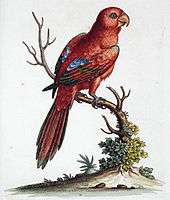Red lory
The red lory (Eos bornea) is a species of parrot in the family Psittaculidae. It is the second-most commonly kept lory in captivity, after the rainbow lorikeet.
| Red lory | |
|---|---|
.jpg) | |
| At Taronga Zoo, Sydney, Australia | |
| Scientific classification | |
| Kingdom: | Animalia |
| Phylum: | Chordata |
| Class: | Aves |
| Order: | Psittaciformes |
| Family: | Psittaculidae |
| Genus: | Eos |
| Species: | E. bornea |
| Binomial name | |
| Eos bornea | |
| Synonyms | |
| |
Description

The red lory is about 31 cm (12 in) long. They weigh 30-300 grams.[2] It is mostly red and all the plumage of the upper body is red. There are red, blue, and black marks on the back and wings, and the tail is reddish-brown with blue under-tail coverts. The beak is orange and the legs are grey. The irises are red except in E. b. bernsteini, which has brown irises. There is no bare skin at the base of the lower mandible. The male and female have identical external appearance. Juveniles are duller and have brown irises and a brownish beak.[3] Their bills are narrower and less powerful than other types of parrots and their gizzards are generally thin-walled and weak. A defining characteristic of a Lory is their brush tongues with papillae at the tips to help them feed on pollen and nectar.[4]
Distribution and habitat
Lories and Lorikeets live in Indonesia, New Guinea, Australia and the Pacific.[4] The red lory in particular is endemic to the Moluccas and surrounding islands in Indonesia. Its natural habitats are tropical moist lowland forests and tropical mangrove forests. It also was introduced to Maldives and released by hotel owners to enrich poor local terrestrial avifauna (which includes only few common Indian land birds such as common myna, Asian koel and House crow) and began to establish there.
Aviculture
This intelligent bird has a playful personality and a colourful appearance. They're often described as flamboyant, theatrical and pugnacious birds.[4] The subspecies, Buru red lory (Eos bornea cyanonothus) is darker, more maroon in colour, and is often confused in captivity with the nominate. Inadvertent interbreeding between the two subspecies has made a clear identification difficult for pet owners as hybrids can be found. The other two subspecies are not as common, Rothschild's red lory (Eos bornea rothschildi) and Bernstein's red lory (Eos bornea bernsteini). Lories are very intelligent, trainable, affectionate, playful and curious and they can display some interesting behaviors. For example, some lories have wrapped themselves in a washcloth for sleeping or some sleep on their backs with their feet up in the air. When kept as a pet, they should be given toys (ropes, bells, balls, swings), chewing items and branches. They require much attention and care. They should be bathed frequently in a bird bath, bowl or shower, and they can be dried by the sun or by a blow drier. A moderate amount of their feathers should be clipped to prevent them from flying. Young birds must be socialized and exposed to new people and new things (new cages, toys, vet visits, wing and nail clippings). Outdoor housing is preferred, but if housed in cages, the cages must be large and cleaned often. They may be kept alone or with others, as long as they're closely monitored for signs of aggression. Mated pairs defend their territories forcefully.[2][5]
Diet
In the wild, lories eat nectar, pollen, fruits, and occasional insects. As pets they should be fed a good formulated diet. Smaller lories should be fed fresh nectar (commercial or home-made) daily. Larger birds can be fed pellets from a bird food company, or fruits and vegetables such as apples, pomegranates, papaya, grapes, cantaloupe, pineapple, figs, kiwi, and corn-on-the-cob. Lories can be given treats to reward positive behavior. Fresh, clean water should be provided daily.[2][5]
Gallery
_Jurong_Bird_Park2-3c.jpg)
 Jurong BirdPark, Singapore, Jurong
Jurong BirdPark, Singapore, Jurong
References
- BirdLife International (2012). "Eos bornea". IUCN Red List of Threatened Species. 2012. Retrieved 26 November 2013.CS1 maint: ref=harv (link)
- "Red Lory". Pretty Bird International Inc. Archived from the original on March 6, 2013. Retrieved December 11, 2012.
- Forshaw (2006). plate 9.
- Parrots, lories and cocatoos. (2003). In C. Perrins (Ed.), The new encyclopedia of birds (1 rev ed.). Oxford University Press.
- Foster, & Smith. (n.d.). Red Lory. Retrieved December 11, 2012, from Pet Education website: http://www.peteducation.com/ article.cfm?c=15+1840&aid=2306
- "Species factsheet: Eos bornea". BirdLife International (2008). Retrieved 20 March 2009.
- Rosemary Low. Encyclopedia of Lories (1998)
Cited texts
- Forshaw, Joseph M. (2006). Parrots of the World; an Identification Guide. Illustrated by Frank Knight. Princeton University Press. ISBN 0-691-09251-6.
External links
- Red Lory (Eos bornea) videos and photos at Internet Bird Collection
| Wikimedia Commons has media related to Eos bornea. |
